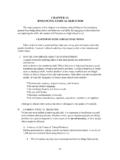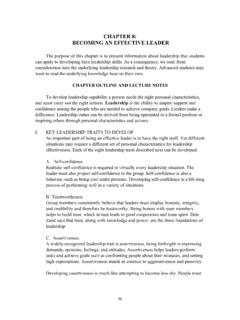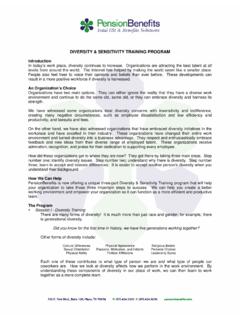Transcription of CHAPTER 6: CROSS-CULTURAL RELATIONS AND …
1 66 CHAPTER 6: CROSS-CULTURAL RELATIONS AND DIVERSITYThe purpose of this CHAPTER is to provide the reader with insight into, andskills for, relating effectively to people from other cultures. Relating effectively todiverse people within one s own culture or from other cultures requires similarknowledge and OUTLINE AND LECTURE NOTESAs is well known, today s workplace is diverse. Minority group members inthe United States are growing seven times as fast as the majority and workers from other countries occupy 26 percent of jobs.
2 Culturaldiversity is also reflected in the increasing internationalization of business. Tosucceed in today s workplace one must be able to relate effectively to people fromdifferent cultural groups from within and outside his or her THE diversity UMBRELLATo appreciate diversity , a person must go beyond tolerating and treatingpeople fairly from different racial and ethnic groups. The true meaning ofdiversity is to respect and enjoy a wide range of cultural and individualdifferences. To be diverse, is to be different in some measurable way even ifthe difference is not apparent on the diversity umbrella is supposed to include everybody in an value diversity is to appreciate individual differences among people.
3 Thegoal of a diverse organization is for persons of all cultural backgrounds toachieve their full potential, not restrained by group identities such as sex,nationality, or as well as individual factors contribute to cultural diversity . Forexample, people can be diverse because of ethnicity or their UNDERSTANDING cultural DIFFERENCESThe male-female differences in communication patterns described inChapter 3 represent one aspect of cultural differences. The groundwork fordeveloping effective CROSS-CULTURAL RELATIONS is to understand Competency GoalsSetting competency goals will improve one s chances of effectivelyunderstanding cultural cultural Sensitivity.
4 To relate well to a person from a foreign country,a person must be alert to possible cultural differences. When workingin another country, one must be willing to acquire knowledge aboutlocal customs, and learn how to speak the native language at leastpassably. cultural sensitivity is an awareness of and a willingness toinvestigate the reasons why people of another culture act as they cultural sensitivity enhances interpersonal relationships. 2. Respect for All Workers and Cultures. An effective strategy forachieving CROSS-CULTURAL understanding is to respect all others in theworkplace (white males included).
5 Respect comes from cultural Fluency. A high-level goal in understanding culturaldifferences is to achieve cultural fluency, the ability to conductbusiness in a diverse, international environment. Achieving culturalfluency includes a variety of skills such as relating well to people fordifferent cultures, and knowing a second Dimensions of Differences In cultural ValuesOne way to understand how national cultures differ is to examine theirvalues. Text Table 6-1 compares values in the United States to the collectivevalues of many Western and Eastern countries.
6 Here we deal with eight Individualism versus collectivism. Individualism is a mental set inwhich people see themselves first as individuals and believe thattheir own interests take priority. Collectivism is a feeling that thegroup and society receive top Power distance. The extent to which employees accept the idea thatmembers of an organization have different levels of power is referredto as power distance. In a high power-distance culture the bossmakes many decisions simply because she or he is the avoidance.
7 People who accept the unknown, and toleraterisk and unconventional behavior, are said to have low uncertaintyavoidance. A society ranked high in uncertainty avoidance contains amajority of people who want predictable and certain versus concern for others. In this context, materialismrefers to an emphasis on assertiveness and the acquisition of moneyand material objects. It also means a de-emphasis on caring forothers. At the other end of the continuum is concern for others, anemphasis on personal relationships and a concern for the welfare Long-term orientation versus short-term orientation.
8 Workers froma culture with a long-term orientation maintain a long-rangeperspective, thus being thrifty and not demanding quick returns ontheir investments. A short-term orientation is characterized by ademand for immediate results and a propensity not to Formality versus informality. A country that values formalityattaches considerable importance to tradition, ceremony, social,rules, and rank. Informality refers to a casual attitude towardtradition, ceremony, social rules, and Urgent time orientation versus casual time orientation, People withan urgent time orientation perceive time as a scarce resource andtend to be impatient.
9 People with a casual time orientation viewtime as an unlimited and unending resource and tend to be High context versus low context cultures. Cultures differ in howmuch importance they attach to the surrounding cultures make more extensive use of body language.(Examples include Hispanics and African-Americans.) Low-context cultures make less use of body language. People inlow-context cultures seldom take time in business dealings to buildrelationships and establish starting point in using information about cultural differenceswould be to recognize that a person s national values might influencehis or her behavior.
10 Two dimensions of cultural differences thatinfluence job behavior considerably are attitudes toward hierarchy and status, and time-consciousness. For example, a person whovalues deference might not want to collaborate in decision makingwith a manager of long experience. C. cultural BloopersAn effective way of being culturally sensitive is to minimize actions that arelikely to offend people from another culture based on their values. Inattempting to avoid cultural mistakes, remember that members of anycultural group show individual differences.















